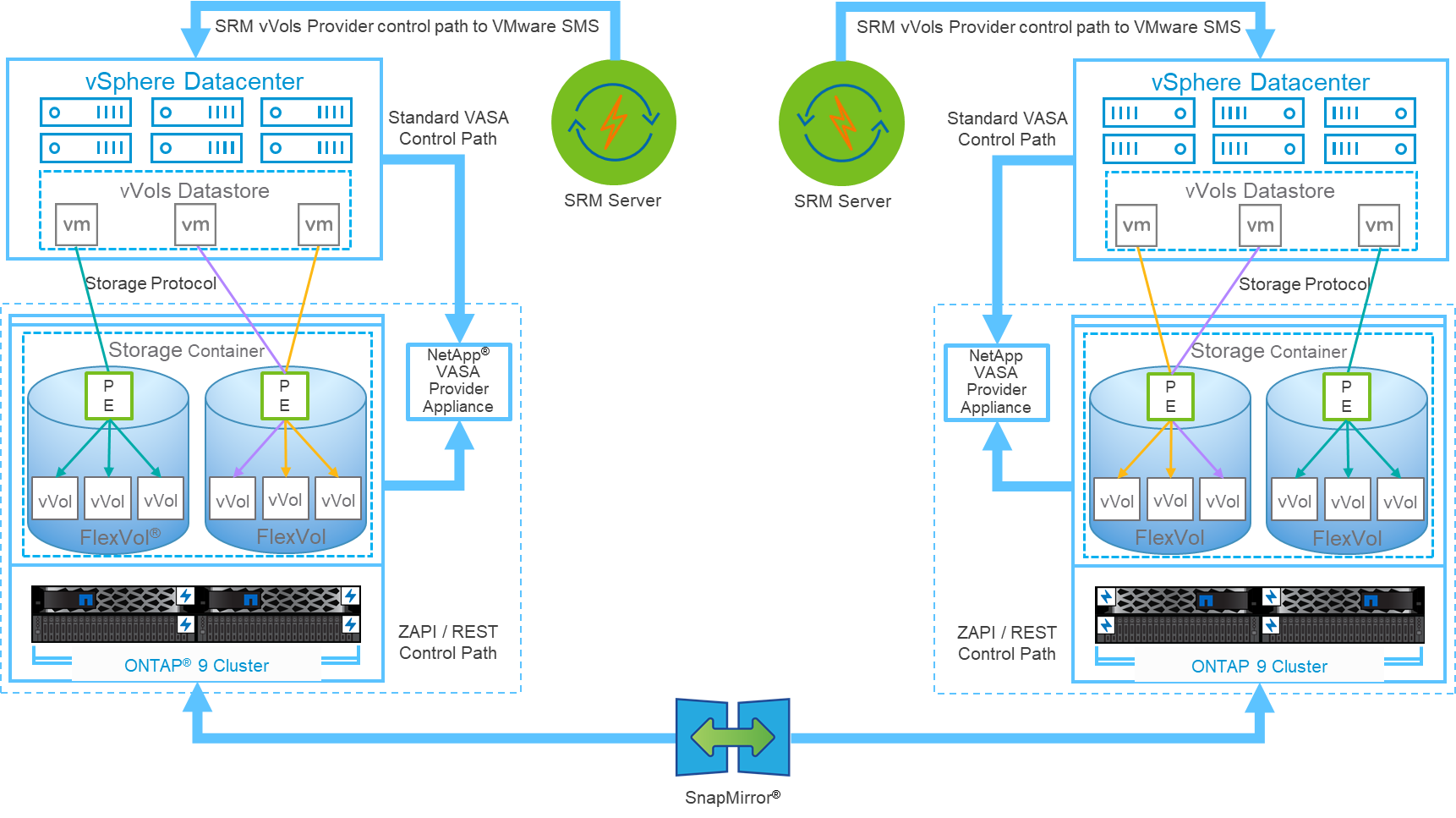Technical materials and best practices
New features with SRM and ONTAP Tools
With the transition from the legacy virtual appliance, ONTAP tools brings a wealth of new features, higher limits, and new vVols support.
Latest versions of vSphere and Site Recovery Manager
With the release of SRM 8.7 and later and the 9.12 and later releases of ONTAP tools, you are now able to protect VMs running on VMware vSphere 8 update 1.
For the latest qualified combinations of software, contact support personnel.
vVols support (and why SPBM matters, even with SRM)
Starting with the 8.3 release, SRM now supports storage policy-based management (SPBM) of replication leveraging vVols and array-based replication for datastores using iSCSI, FCP, and NFS v3. To accomplish this, the SRM server was updated to include a new SRM vVols provider service, which communicates to the vCenter server’s SMS service for VASA related tasks.
One advantage to this architecture is that an SRA is no longer needed since everything is handled using VASA.
SPBM is a powerful tool in the vSphere toolbox, allow simplified, predictable, and consistent storage services for consumption by automation frameworks in private and hybrid cloud environments. Fundamentally, SPBM allows you to define classes of service that meet the needs of your diverse customer base. SRM now allows you to expose replication capabilities to your customers for critical workloads requiring robust industry-standard disaster- recovery orchestration and automation.
vVols Architecture example with FCP or iSCSI:

Support for appliance-based SRM servers
Photon OS-based SRM servers are now supported, in addition to legacy Windows-based platforms.
You can now install SRA adapters regardless of your preferred SRM server type.
Support for IPv6
IPv6 is now supported with the following limitations:
-
vCenter 6.7 or later
-
Not supported with SRM 8.2 (8.1, 8.3, and 8. 4 are supported)
Improved performance
Operational performance is a key requirement for SRM task execution. To meet the requirements of modern RTOs and RPOs, the SRA with ONTAP tools has added three new improvements.
-
Support for concurrent reprotect operations. First introduced in SRA 9.7.1, enabling this feature allows you to run reprotect on two or more recovery plans concurrently, thus reducing the time required to reprotect datastores after a failover or migration and remain within your RTO and RPO parameters.
-
ONTAP Tools 9.8 adds a new NAS- only optimized mode. When you use SVM- scoped accounts and connections to ONTAP clusters with only NFS based datastores, you can enable NAS-only optimized mode for peak performance in supported environments.
-
ONTAP Tools 9.12 added support for ONTAP’s SnapMirror quick resync feature. This enables rapid resyncronization of mirrors at the exense of having to recalculate storage efficency savings post process. This feature is not used by default, but can be enabled in large scale environments where traditional resync takes too long or is timing out.
Greater scale
The ONTAP tools SRA can now support up to 500 protection groups (PGs) when used with SRM 8.3 and later.
Synchronous replication
A long awaited and much anticipated new feature is SnapMirror Synchronous (SM-S) with ONTAP 9.5 and later which delivers a volume granular zero RPO data replication solution for your mission-critical applications. SM-S requires ONTAP tools 9.8 or later.
REST API support
SRA server configuration can now be managed by REST APIs. A Swagger UI has been added to assist in building your automation workflows and can be found on your ONTAP tools appliance at https://<appliance>:8143/api/rest/swagger-ui.html#/.
